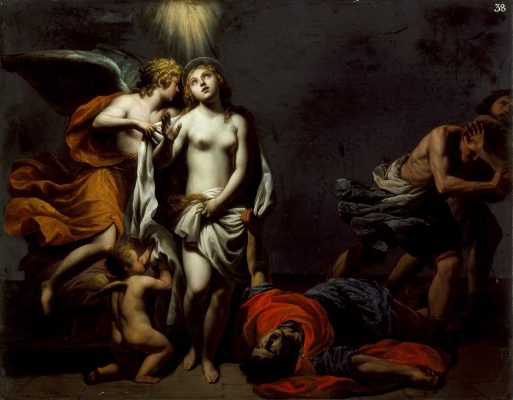“The blood of the martyrs,” wrote Tertullian, “is the seed of the Church.”
In 305 A.D., thirteen-year-old Agnes rebuked the pagan son of the Roman prefect, who desired her in marriage, telling him she was already engaged to a far better lover. “He has dressed me in the robes of a princess. He has placed his sign on my forehead, and I shall have no other lover.”
Stripped naked and brought to a brothel, Agnes received protection from rape by an angel. The Romans killed her by stabbing her in the throat. Agnes,“lamb” in Latin, also means “pure” in Greek. Her feast day falls on January 21.
 By
Alessandro Turchi (called Orbetto) (Italy, Rome, 1578-1649) - Image:
http://collections.lacma.org/sites/default/files/remote_images/piction/ma-31776681-O3.jpgGallery:
http://collections.lacma.org/node/250141, Public Domain,
Link
By
Alessandro Turchi (called Orbetto) (Italy, Rome, 1578-1649) - Image:
http://collections.lacma.org/sites/default/files/remote_images/piction/ma-31776681-O3.jpgGallery:
http://collections.lacma.org/node/250141, Public Domain,
Link
Another early martyr also commemorated in the Roman Canon, St. Lucy prayed at Agnes’ tomb before her own martyrdom. Lucy, “light” in Latin, had her eyes plucked out.
[Tweet "We like to believe in the meaning of our actions, but often it can only be uncovered later."]
We like to believe in the meaning of our actions, but many times meaning can only be uncovered long after the fact. Take naming children, for instance. We named our youngest child Agnes Lucia.
 Photo courtesy Jacqueline O'Connor 2016. All rights reserved.
Photo courtesy Jacqueline O'Connor 2016. All rights reserved.
We’re visiting Rome in May. My brother Peter, who travels to Rome annually, recommended a book for me about Sant’ Agnese fuori le mura (Saint Agnes outside the walls), the church where St. Agnes is buried. The book is called The Geometry of Love, by the wonderful writer Margaret Visser.
The book is an extended meditation on the meaning of churches, and Visser chose this church as her subject. This unexpected choice rewards both author and reader with an abundance of riches.
She describes the origin of the pallium worn by popes and bishops, signifying their authority. Popes wear it everywhere, bishops only in their diocese. Since Christ commanded St. Peter three times to “feed my sheep,” the pallium, naturally, is made from wool. Also, it is placed near the tomb of St. Peter before a bishop receives it, which is not until after the feast of Sts. Peter and Paul.
A pair of lambs whose wool is used in making the palliums, though, first are blessed on January 21 at the church of Sant’ Agnese fuori le mura. One wears red flowers, the other white, to symbolize St. Agnes--both martyr and virgin.
In November 1887, Therese Martin visited Sant’ Agnese with her family. Her older sister, Pauline, had already entered a convent in France and taken the name Sister Agnes. Therese prayed for a memento, “one of the relics” for her sister. Suddenly, “a little red stone” detached itself from a “rich mosaic.” Agnes answered Therese’s prayer. You can find this story in St. Therese’s spiritual autobiography, The Story of a Soul. Pauline, by then Mother Agnes, asked her to write it.
My own Agnes has a sister named Catherine Therese. Of course she does.
So, while other pilgrims to Rome flock to St. Peter’s, St. John Lateran, and St. Mary Major, we’ll be outside the walls, in a quiet neighborhood. We’ll duck through a gate, cross a courtyard, and descend an ancient staircase. We’ll visit the tomb of a young girl, a powerless victim of the brutal Roman empire 1,700 years ago. Her actions, so meaningless and irrational to her attackers, like a pomegranate seed continue to bear fruit.
St. Agnes, pray for us!
Copyright 2017 Kiernan O'Connor
About the Author

Guest
We welcome guest contributors who graciously volunteer their writing for our readers. Please support our guest writers by visiting their sites, purchasing their work, and leaving comments to thank them for sharing their gifts here on CatholicMom.com. To inquire about serving as a guest contributor, contact editor@CatholicMom.com.


.png?width=1806&height=731&name=CatholicMom_hcfm_logo1_pos_871c_2728c%20(002).png)
Comments